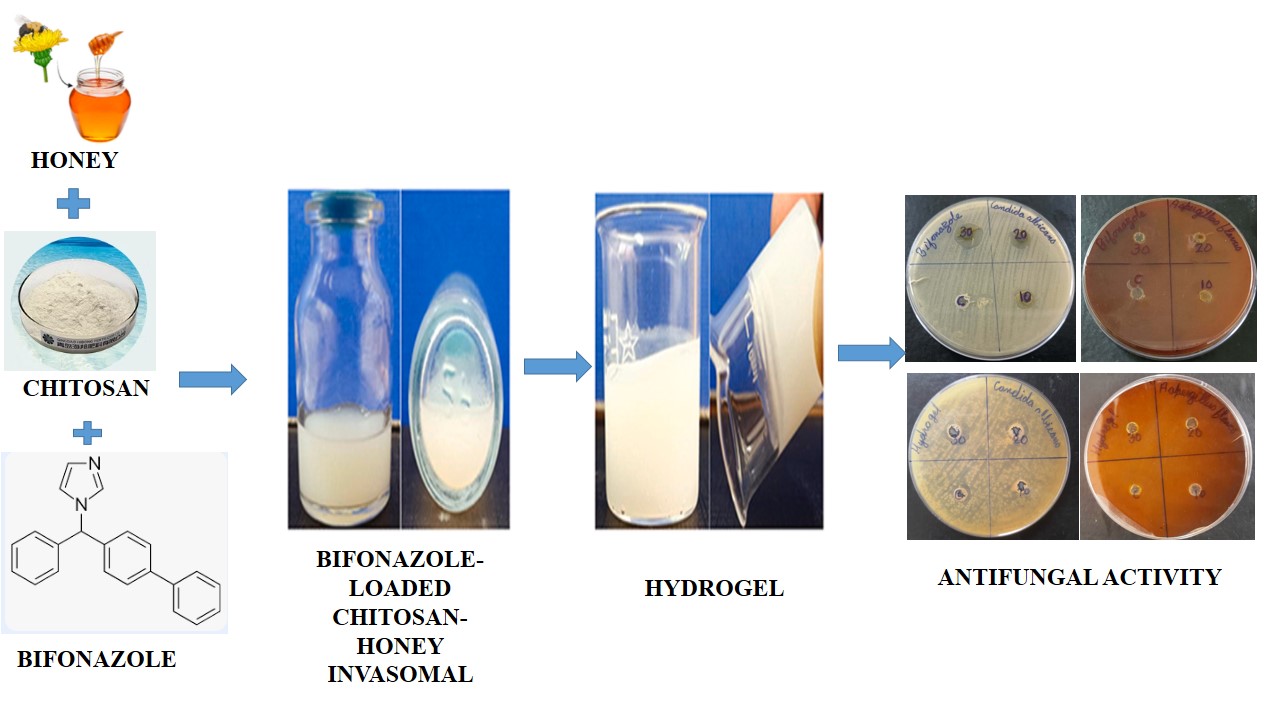Formulation and evaluation of a bifonazole-loaded chitosan-honey invasomal hydrogel for enhanced topical antifungal activity
DOI:
https://doi.org/10.69857/joapr.v13i4.1301Keywords:
Bifonazole, Chitosan, Honey, Invasomal vesicles, Hydrogel, Topical drug delivery, Antifungal therapy, Skin permeation, Sustained release, Drug entrapmentAbstract
Background: To develop a novel bifonazole-loaded chitosan-honey invasomal hydrogel to improve the drug's topical antifungal efficacy. In this formulation, invasomal vesicles, composed of phospholipids, ethanol, and terpenes, were utilized to enhance the penetration of bifonazole through the skin. Methodology: These invasomal carriers were incorporated into a chitosan-based hydrogel matrix, which provided structural stability and bioadhesive properties, allowing for better retention on the skin. Additionally, natural honey, known for its antibacterial and wound-healing properties, was included to enhance the therapeutic benefits of the hydrogel. Results & Discussion: Invasomes were prepared using soya phosphatidylcholine, ethanol (30% v/v), and d-limonene (0.5%) and then incorporated into a chitosan-honey gel matrix. Among the six formulations (IF1–IF6), IF5 showed optimal results, with 93.32% drug release over 12 hours, a viscosity of 6545 ± 26 cps, a pH of 6.85, and antifungal inhibition zones of 17 mm (Candida albicans) and 11 mm (A. flavus). The formulation was characterized in terms of its physical properties, including viscosity, gel strength, and spreadability, and evaluated for its drug entrapment efficiency, in vitro drug release profile, and ex vivo skin permeation. This study demonstrates a synergistic system enhancing skin permeation, drug retention, and antifungal efficacy. Conclusion: This formulation represents a promising alternative for the effective and patient-friendly treatment of superficial fungal infections, offering improved drug delivery, enhanced therapeutic efficacy, and a reduced dosing frequency.
Downloads
References
Yasin SN, Said Z, Halib N, Rahman ZA, Mokhzani NI. Polymer-based hydrogel loaded with honey in drug delivery system for wound healing applications. Polymers, 15(14), 3085 (2023) https://doi.org/10.3390/polym15143085.
Sousa F, Ferreira D, Reis S, Costa P. Current insights on antifungal therapy: Novel nanotechnology approaches for drug delivery systems and new drugs from natural sources. Pharmaceuticals, 13(9), 248 (2020) https://doi.org/10.3390/ph13090248.
Mishra AK, Kumar A, Singh H, Verma S, Sahu JK, Mishra A. Chemistry and pharmacology of luliconazole (imidazole derivative): a novel bioactive compound to treat fungal infection—a mini review. Curr. Bioact. Compd., 15(6), 602–609 (2019) https://doi.org/10.2174/1573407214666180717111419.
Suñer-Carbó J, Calpena-Campmany A, Halbaut-Bellowa L, Clares-Naveros B, Rodriguez-Lagunas MJ, Barbolini E, Zamarbide-Losada J, Boix-Montañés A. Biopharmaceutical development of a bifonazole multiple emulsion for enhanced epidermal delivery. Pharmaceutics, 11(2), 66 (2019) https://doi.org/10.3390/pharmaceutics11020066.
Atanasova D, Staneva D, Grabchev I. Textile materials modified with stimuli-responsive drug carrier for skin topical and transdermal delivery. Materials, 14(4), 930 (2021) https://doi.org/10.3390/ma14040930.
Egorov AR, Kirichuk AA, Rubanik VV, Rubanik Jr VV, Tskhovrebov AG, Kritchenkov AS. Chitosan and its derivatives: preparation and antibacterial properties. Mater., 16(18), 6076 (2023) https://doi.org/10.3390/ma16186076.
Lin Z, Gao W, Hu H, Ma K, He B, Dai W, Wang X, Wang J, Zhang X, Zhang Q. Novel thermo-sensitive hydrogel system with paclitaxel nanocrystals: High drug-loading, sustained drug release and extended local retention guaranteeing better efficacy and lower toxicity. J. Control. Release, 174, 161–170 (2014) https://doi.org/10.1016/j.jconrel.2013.10.026.
Tashkandi H. Honey in wound healing: An updated review. Open Life Sci., 16(1), 1091–1100 (2021) https://doi.org/10.1515/biol-2021-0084.
Nezhad-Mokhtari P, Javanbakht S, Asadi N, Ghorbani M, Milani M, Hanifehpour Y, Gholizadeh P, Akbarzadeh A. Recent advances in honey-based hydrogels for wound healing applications: Towards natural therapeutics. J. Drug Deliv. Sci. Technol., 66, 102789 (2021) https://doi.org/10.1016/j.jddst.2021.102789.
Jain S, Tripathi S, Tripathi PK. Invasomes: Potential vesicular systems for transdermal delivery of drug molecules. J. Drug Deliv. Sci. Technol., 61, 102166 (2021) https://doi.org/10.1016/j.jddst.2020.102166.
Garg A, Sharma GS, Goyal AK, Ghosh G, Si SC, Rath G. Recent advances in topical carriers of anti-fungal agents. Heliyon, 6(8), e04521 (2020) https://doi.org/10.1016/j.heliyon.2020.e04663.
Patil S, Bhargav S. Advanced invasomal delivery system for enhanced topical application of bifonazole in fungal infections. Prospect. Pharm. Sci., 23(1), 102–110 (2025) https://doi.org/10.56782/pps.317.
El-Housiny S, Fouad AG, El-Bakry R, Zaki RM, Afzal O, El-Ela FIA, Ghalwash MM. In Vitro and in vivo characterization of nasal pH-responsive in-situ hydrogel of candesartan-loaded invasomes as a potential stroke treatment. Drug Deliv. Transl. Res., 15(5), 1626–1645 (2025) https://doi.org/10.1007/s13346-024-01700-z.
Chopra H, Kumar S, Singh I. Bioadhesive hydrogels and their applications. In: Bioadhesives in Drug Delivery, 147–170 (2020) https://doi.org/10.1002/9781119640240.ch6.
Mathur M, Devi VK. Potential of novel drug delivery systems in the management of topical candidiasis. J. Drug Target., 25(8), 685–703 (2017) https://doi.org/10.1080/1061186X.2017.1331352.
Akhtar N, Verma A, Pathak K. Topical delivery of drugs for the effective treatment of fungal infections of skin. Curr. Pharm. Des., 21(20), 2892–2913 (2015) https://doi.org/10.2174/1381612821666150428150456 .
Gaynanova G, Vasileva L, Kashapov R, Kuznetsova D, Kushnazarova R, Tyryshkina A, Vasilieva E, Petrov K, Zakharova L, Sinyashin O. Self-assembling drug formulations with tunable permeability and biodegradability. Molecules, 26(22), 6786 (2021) https://doi.org/10.3390/molecules26226786.
Şalva E, Akdağ A.E., Alan S., Arısoy S., Akbuğa F.J. Evaluation of the Effect of Honey-Containing Chitosan/Hyaluronic Acid Hydrogels on Wound Healing. Res. J. of Pharm. and Tech., 16(11), 856 (2023) https://doi.org/10.3390/gels9110856.
Zafar A, Yasir M, Singh L, Jafar M, Warsi MH, Panda DS. Luteolin-loaded invasomes gel for transdermal delivery: Development, optimization, in-vitro, and preclinical evaluation. J. Oleo Sci., 73(9), 1221–1240 (2024) https://doi.org/10.5650/jos.ess24041.

Published
How to Cite
Issue
Section
Copyright (c) 2025 Shivaji Patil, Sushil Bhargav

This work is licensed under a Creative Commons Attribution-NonCommercial 4.0 International License.
















